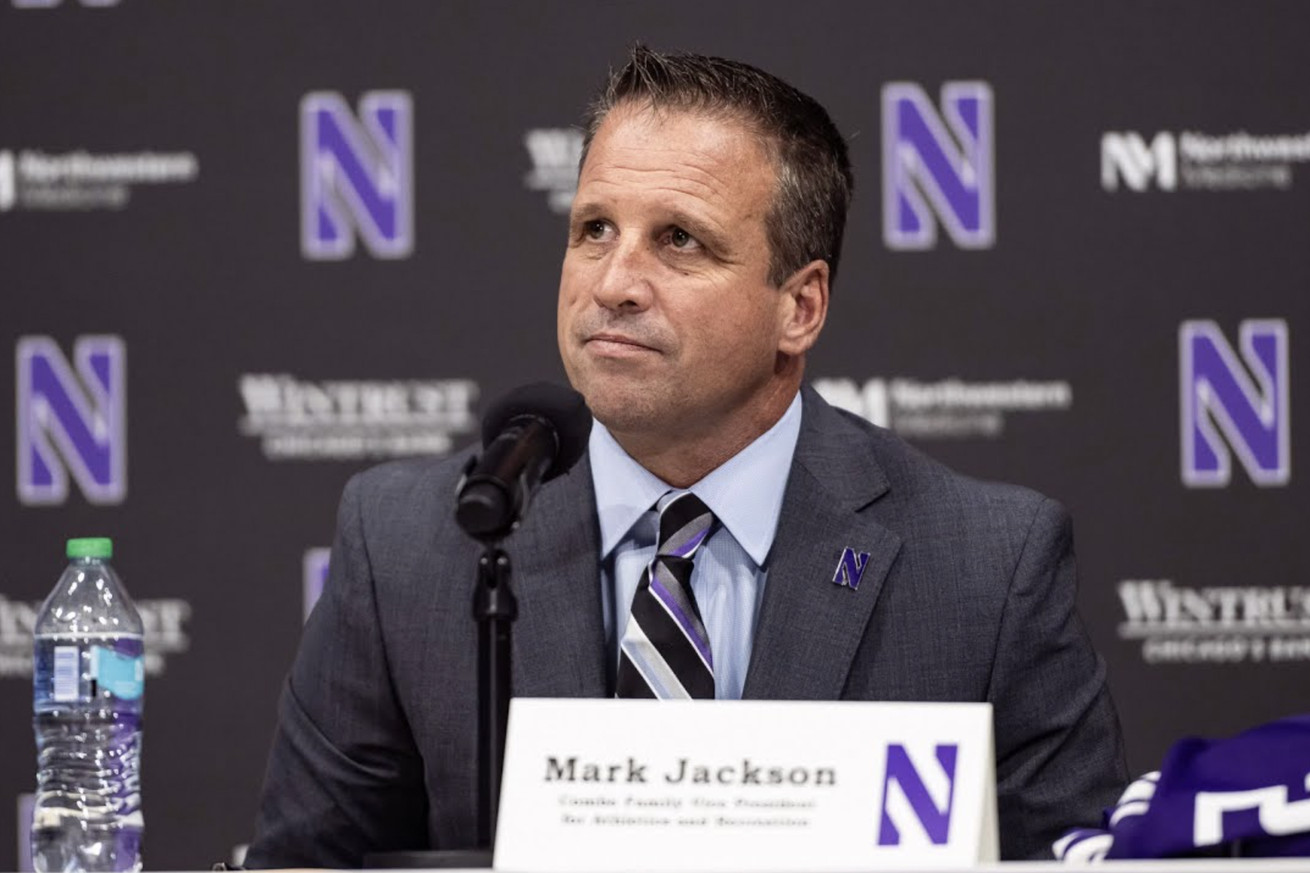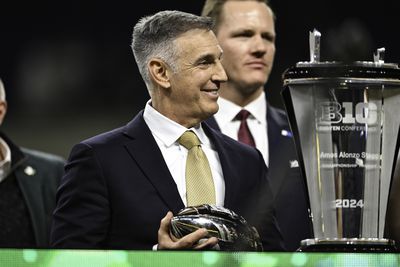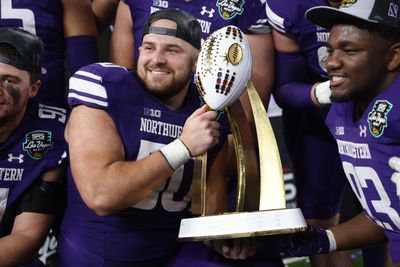
AD Mark Jackson and Co. are ready to face a brave new world.
We have officially crossed the Rubicon of college sports, and Northwestern is along for the ride.
Amateurism, the long-fading ideal governing intercollegiate athletics for the better part of the last three centuries, officially died a drawn-out death with the approval of the House v. NCAA settlement on Friday night.
The settlement was signed by U.S. District Judge Claudia Wilken at 8:00 p.m. CDT on June 6, permitting schools that opt-in the ability to share up to $20.5 million in revenue with their student-athletes for the 2025-26 academic year. House’s implementation is immediate; athletic departments will be able to begin paying players directly starting on July 1.
Among the questions that Northwestern AD Mark Jackson will have to address are new roster limits — most urgently the 105-man cap on football — a new NIL monitoring committee and how best to allocate that $20.5 million.
The ‘Cats has been gearing up to face the post-House world for the better part of the past year.
On May 13, Northwestern hired former Cincinnati Bengals scout Christian Sarkisian to serve as the first general manager of its athletic department. His responsibilities include overseeing “the operational functions related to the NCAA House settlement,” in addition to “all aspects of salary cap management,” per a Northwestern press release.
In an interview with The Daily Northwestern published last week, AD Jackson stated his intention to build the Northwestern athletic department in a “C-suite” model, citing the recent hirings of Jesse Marks as Chief Revenue Officer and Savanna Wood as Chief Communications and Branding Officer.
“Those positions are all uniquely designed to help navigate what’s coming at us,” Jackson told The Daily.
The short answer to the question, “How does the House v. NCAA ruling affect Northwestern Athletics?” is that we don’t know. Friday night’s final agreement cleared up many immediate uncertainties, but the questions still far outnumber the answers.
Is this the end of NIL as we know it? Sort of. The settlement requires that any deals struck between a student-athlete and a potential third party after July 1 be subject to a new clearinghouse run by Deloitte to ensure that they are legitimate sponsorship agreements based on a student athlete’s name, image and likeness — and not the pay-to-play deals that have dominated the college athletics landscape for the better part of the last four years.
Per a press release from the Big Ten, Deloitte will evaluate any future deals based on three criteria: “payor association,” “valid business purpose” and the “range of compensation.” Payments from the newly created $20.5 million pool will come directly from schools, and not NIL collectives. That’s for sure the end of Northwestern’s TrueNU, at least as it currently operates.
Here are the specific standards any deals over $600 must pass, right from the Big Ten’s release:
- Payor association: The relationship between the payor and the student-athlete’s school.
- Valid business purpose: Whether the payor is seeking the use of the student-athlete’s NIL for a valid business purpose, meaning to sell a good or service to the public for profit.
- Range of compensation: Whether the compensation paid to the student-athlete is commensurate with compensation paid to similarly situated individuals.
On paper, this new regulatory board is a massive win for schools like Northwestern. Five-star recruits will still get the most lucrative deals, and schools like Michigan and Texas do grant larger brand exposure than Northwestern, but a salary cap should iron out most of Northwestern’s NIL shortcomings, at least in a perfect world. Ohio State Athletic Director Ross Bjork told everyone who would listen that his 2025 national championship football roster cost more than $20 million. The Buckeyes will never be Northwestern’s barometer, but the hope for the ‘Cats has to be that House closes the gap.

Photo by Jamie Squire/Getty Images
Placing college athletics under the purview of an all-seeing NIL oversight committee after four years in an anything-goes Wild West frontier is easier said than done. Like most, I’ll remain skeptical of the Deloitte clearinghouse, which the accounting firm has named “NIL Go,” until it shows its teeth as an enforcement authority. The Alabamas and LSUs of the world will unlock some never-before-seen legal gymnastics to skirt this newly formed review board. Despite what Nick Saban will have you believe, his Crimson Tide have been finding ways to get money to its players for decades. NIL Go has been in operation for under a month.
An anonymous Power Four personnel director told The Athletic’s Justin Williams that there is “no chance” that House stops these thinly veiled pay-for-play payments.
Like every other school that will opt in to House, Northwestern will most likely share the majority of its $20.5 million in allocable revenue with its football team, a good portion with men’s basketball, a lesser portion with women’s basketball and relatively little with its 16 other varsity programs.
Texas Tech is a helpful, if random, example as one of few schools that have publicly stated the amount of the $20.5 million pool it will allocate per team. In an interview from last December, Texas Tech AD Kirby Hocutt said the Red Raiders will spend about 74% on football, 17-18% to men’s basketball, 2% to women’s basketball, 1.9% to baseball and smaller percentages to other sports, per the Lubbock Avalanche-Journal.
Northwestern’s numbers will undoubtedly be a little different — stars of non-revenue sports like two-time Tewaaraton finalist and all-time NCAA single-season scoring record holder Madison Taylor should get a piece of that $20.5 million pie — but the crux of the distribution numbers remain the same. The House settlement means a great deal for Northwestern football, and men’s and women’s basketball. Perhaps student-athletes on Northwestern women’s golf, lacrosse and field hockey programs that all have won national championships since 2023 will receive some additional cash, but at this point, it’s impossible to speculate how much — or if they will receive any at all. The post-House world will feature some Title IX litigation.
In that same interview with the Lubbock Avalanche-Journal, Texas Tech’s Hocutt said his Red Raiders will not be increasing the number of athletic scholarships it gives out, as that added cost will cut into its revenue. A lesser-talked about piece of this new post-House reality is that $20.5 million is a lot of revenue to share. USA Today’s Steve Berkowitz reports that Northwestern will likely receive around $75 million in revenue from the Big Ten in the fiscal year 2025, up from about $63.2 million in 2024 (Northwestern doesn’t disclose these numbers as a private university, so that number is an estimate from its Big Ten peers).
To put those numbers in perspective, the SEC distributed an average of $52.5 million per school in 2024. The ACC shared an estimated $45 million per school, per ESPN. All indications are that every Power Four school will share every penny of that $20.5 million cap. Northwestern, of course, lags behind many of its Power Four peers in other metrics, but House should amplify the benefits reaped by Northwestern for its membership in the Big Ten.

Photo by James Black/Icon Sportswire via Getty Images
The most immediate implications of the settlement concern House’s 105-man roster limit for football that will go into effect for this upcoming fall season. However, the final agreement signed on Friday night included provisions suggesting that schools would be allowed to grandfather in student-athletes who would have otherwise lost a roster spot due to the new regulations.
The language reads, “Any athlete who would have lost their roster spot (or a promised roster spot) for the 2025-2026 academic year due to the immediate implementation of roster limits will be exempt from any roster limits at any Division I institution, for the duration of their college athletics careers.”
Judge Wilken postponed the initial settlement date in April due to concerns regarding these potential cuts, urging House’s lawyers to modify the settlement in order to accommodate class members who “may ultimately have lost roster spots as a result of the Settlement” in an order on April 23.
Braun offered a sharp critique of the roster limits at Northwestern’s open practice on April 19, three days before Judge Wilken’s move to postpone the final ruling, citing the developmental opportunities that a program like Northwestern would lose without space for walk-ons. The pre-House regulations included a hard cap of 85 scholarships with no limits to the actual number of players that teams could roster. The House settlement raises the scholarship limit to 105, but that spike comes with a roster cap that does not exist under the current system.
Braun cited defensive lineman PJ Spencer as a guy who would not have gotten an opportunity to play under the current system. Spencer, who came to Evanston as a walk-on in 2019, played in all thirteen games during his senior season in 2023, recording two tackles in Northwestern’s win over Utah in the Las Vegas Bowl.
“We’re eliminating opportunities for young men to develop,” said Braun back in April. “If you were to ask people in the program when PJ came in as a walk on, is this guy gonna be something that helps us go beat Utah in Las Vegas? I don’t want those stories to not continue to be part of college football.”
Northwestern has 116 players on its 2025-26 roster. For now, the addition of House’s “grandfathering” clause appears to mean that Northwestern’s walk-ons will not lose those opportunities — at least during the 2025-26 football season.

Photo by Zak Krill/Getty Images
Football is not the only sport with a roster limit. Northwestern men’s basketball will be able to grant 15 scholarships in 2025-26, up from the old number of 13. Head coach Chris Collins’ side currently includes 15 players, but notably, just 13 are on scholarship, with walk-ons Gus Hurlburt and Blake Smith filling the remaining two slots.
Hurlburt and Smith will be theoretically in-line to receive scholarships as soon as the settlement goes live on July 1, and Collins has given no indication that he intends to replace his two walk-ons through the portal for the upcoming season. Both players will be academic seniors in the fall and should graduate in 2026.
Northwestern is not necessarily handicapping itself by not filling those remaining two scholarship spots. Any new spending on scholarships — which at Northwestern, should total around $90,000 each — would be deducted from the $20.5 million pool. Schools are able to spend as much as $2.5 million on additional scholarships in 2025-26.
Some men’s basketball programs in the Big Ten will undoubtedly give out all 15 scholarships, but not all. To use Texas Tech for another rough case study, the Red Raiders have stated they will not grant any additional football scholarships on top of the old cap of 85. The ‘Cats perhaps could have benefited from an extra scholarship center for the upcoming season, but Collins’ decision not to add one is not merely a sign of loyalty toward Hurlburt and Smith.
Chalk the men’s basketball scholarship question down as another in a long list of things we have to learn regarding the implications of House v. NCAA on Northwestern Athletics in the coming months. I’ll be trying to absorb as much information as I can from New York City, and Inside NU will continue to parse out the implications from our various summer resting places.
In the meantime, I recommend checking out some of these pieces that I read while writing this article.
- Judge Wilken’s April 23 order postponing her ruling in order to accommodate student-athletes who would have been cut due to roster limits
- The Athletic’s Justin Williams on how teams will circumvent Deloitte’s “NIL Go” clearinghouse
- Texas Tech AD Kirby Hocutt on his plan for revenue sharing in the Lubbock Avalanch-Journal
- USA Today’s Steve Berkowitz on the Big Ten’s skyrocketing revenue
